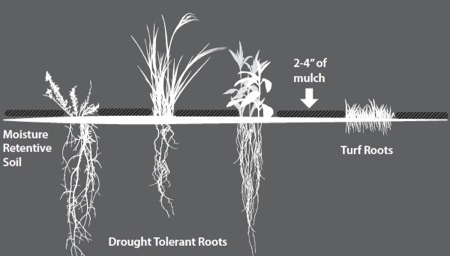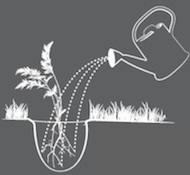Make every raindrop count
Overview
Why pay for the water you use on your garden when rain is free? Rain water is better for your plants because it is at ambient temperature and contains no chlorine. Plus, by reducing the amount of treated water consumed, you’ll be helping the environment. The following methods help make use of every drop of rain water and can greatly reduce or even eliminate the need for supplemental watering.
- Soil with a high percentage of organic content holds a lot more water than other types of soil. Use compost to amend your soil as it is high in organic content.
- Rain gardens are low-maintenance gardens that hold, filter and use rain water.
-
Mulch is effective at slowing down the evaporation of water from the soil and gives you greater control over the temperature of the soil. A 2–4” layer of mulch is recommended to slow evaporation. Be aware that plants should not grow through the mulch and that as a general rule of thumb a circle of 4–6” for plants and 12” for trees should be left mulch-free.

There are a wide range of options including reusing material from your garden, using ground covering plants to shade the soil, and buying organic or inorganic mulch.
See also: All About Mulch, at the Savvy Gardener
- Try xeriscaping! It’s more than just fun to say; see below.
Drought tolerant gardening
Drought tolerant gardening practices (xeriscaping) minimize water use. It does not necessarily mean that all the plants chosen are drought tolerant and can include plants that enjoy wet feet. The following tips will help you design a garden that requires less treated water to thrive.
Plant placement
- Plant drought tolerant species in areas which are usually dry. These areas are usually higher, full sun, high wind locations. Russian Sage, Lavender, Yuccas and some ornamental grasses grow better when dry.
- Group plants with similar characteristics together. For example water loving plants should be planted together in lower lying areas where water flows or collects during rainfall.
- Place the shorter plants at the south end of your beds and the taller ones at the north end. This allows the plants to shade each other and slows the loss of moisture from the soil and from the plants through evaporation and transpiration.
- Place plants to protect each other from the wind; this will also slow evaporation.
Plant selection
- Native plants are adapted to the local conditions and usually require less care and resources than other plants.
- Drought tolerant plants have characteristics which enable them to go long periods without water, making them ideal for low-water-use gardens and areas that are normally very dry.
- Save your drought-tolerant seeds: limit watering and then save the seeds from the plants that performed the best (tip: this only works for open pollinated or “heirloom” seed varieties).
Direct the water from your downspouts, and sump pump outlets, and impervious surfaces into your garden or a rain barrel for later use. By doing this you are harvesting the water. French drains, piping, and the natural lay of the land are simple ways to bring the water to where it needs to be used.
Greener lawn care tips
Lawns are easily one of the thirstiest parts of our landscape. They are also given more fertilizer, pesticides, and herbicides than other parts of our gardens. And, let’s not forget about all that mowing! All of this sums up to a low score for environmental sustainability.
Shrinking or removing your lawn and replacing it with gardens, pathways, and patios is one way to make your landscape greener. There are many ground covers which offer beauty for less maintenance.
For ground cover ideas, visit Utilities Kingston’s Water Conservation Garden. And if you’re considering a patio or pathway, look for materials that are permeable to reduce the risks of runoff pollution. Visit Runoff Pollution and How to Prevent It: Permeable Surfaces.
Of course, lawns are an important and valuable feature of many homes. Here are some important care tips on how to keep yours healthy.
Green grass, less water
- Ask for drought-tolerant grasses such as short fescue from your local supplier. These grasses only need a fraction of the water and stay green much longer.
- Your lawn should be growing on 30 cm or 1' of moisture retentive soil. This is easily done from scratch but can also be achieved by adding a thin layer of topsoil amended with compost every one or two years.
- Cut your grass 2.5"–3" tall. Short grass dries out faster, is under greater stress, and has shallower roots when compared to longer grass.
- Cut no more than 1/3 of the grass’s height at a time. Cutting more causes unnecessary stress to the plan. Mow in increments if your lawn is very tall.
- Aerate your soil. This is done in spring by poking holes in the sod allowing water and oxygen to penetrate to the roots.
- Terrace your lawn as opposed to having it on a slope. This will help the soil absorb water instead of letting it run-off.
- Grass-cycle. No need to rake up those grass clippings. By leaving them you are fertilizing your lawn and adding to its moisture retentiveness. Spread any large clumps of clippings out evenly so they don’t smother your lawn. Make sure to sweep up grass clippings from the street as they can choke fish and plants when washed into our watersheds.
- Clover is good for your lawn. It creates nitrogen and when mowed the leaves decay and fertilize the lawn. Clover is also tolerant of foot traffic.
- Lawns should require no more than 1" of water a week. Watch the weather forecast and measure rainfall to determine how much supplemental water is needed. A rain gauge will measure rainfall and can let you know how long your sprinkler needs to run.
- Grass that goes brown during a dry spell is not dead or dying but simply dormant. It will turn green again when the rains return.
Best watering practices
Before turning on the hose, make sure your plants really need water by using a combination of the following methods.
Look
Droopy plants may indicate a need for water especially if droopy in the morning. Some plants such as Rudbeckia (Brown Eyed Susan) become droopy in very hot weather but not necessarily from a lack of water, so use other tests to check.
Feel
Use the two knuckle soil moisture test. Dig a hole in the soil about two knuckles deep (4 cm/1.5"). With the tips of your fingers touch the bottom of the hole. If it feels moist there is no need to water, if it is dry your plants may be thirsty.
Check
Always keep track of what precipitation is forecasted for your region. There is no point in watering when a good rainfall is likely. Rain gauges are a good way to measure the amount of rainfall your garden has received, or to calculate how long your sprinkler takes to reach a certain amount.
Test
Inexpensive soil moisture testers are available. These will give you a reading on the moisture content in your soil by sticking the probe into the soil.

How
Hand watering and drip irrigation systems are the most effective as you have direct control of where and how much water is applied.
When
The best time to water is in the morning before it gets hot. The earlier you water the better. Avoid watering from 10 a.m. to 4 p.m. as the heat of the sun increases evaporation and water droplets in the sunlight can burn leaves.
Where
Water the soil directly above the roots and not the foliage.

Tips
- An inexpensive timer is a convenient way to water your landscape while obeying Kingston’s water by-laws.
- Coach your plants to be drought tolerant by watering them deeply and less frequently! This can be done by watering the soil above the roots and allowing the water to soak into the soil. You want the water to go deeper than the roots causing the root system to expand.
Practices to avoid
- Do not plant shade-loving plants in the sun, as they will require much more water to survive.
- Do not water on windy days as the wind speeds evaporation.
- Do not use a sprinkler that sprays a fine mist as a lot of the water will be lost into the air. Sprinklers that produce big, fat water droplets are best.
- Do not water close to, or after sundown, as the moisture will encourage the growth of plant disease.
